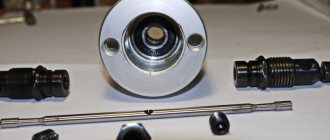One of the modern and popular types of tools is the renovator, which is also called a multitool or oscillator saw. What this device is, its types, operating features and other useful information can be found in this material. This article examines in detail the attachments for the renovator: what they are, for what purposes they are used, and other useful information for those who are just planning to buy this wonderful tool or have already purchased it and are mastering the technique of use.
Wood bits
Wood is one of the most common materials in construction and finishing work, and therefore wood attachments for renovators vary depending on the specific operation with wood:
- for cutting wood, a cutting disk of a spade-shaped, rectangular or other complex shape, called a saw blade, is useful - its functions include plunge-cutting or other sawing not only of wood, but also of other materials (plastic, soft metal, etc.);
- a segmented saw blade has the shape of an incomplete circle, often with a cut edge or with part of a segment of complex shape; sometimes manufacturers complete their multifunctional tools with a full-circle blade;
- for cutting work with wood, you may also need a depth limiter - with its help you can make cuts of certain sizes even without visual control, which will be especially important for hard-to-reach places;
- The rasp disk and sanding pad are used for rough processing of wood and removing large burrs.
Main types of nozzles
Numerous types of equipment are constantly expanding the scope of application of vibrating tools. Today, the market offers a huge variety of attachments of various shapes, for working with wood, metal, plastic, drywall, concrete and many other materials. To make the choice more convenient, universal sets of attachments for the renovator are produced, or those aimed at performing specific tasks.
In most cases, attachments have universal fasteners that fit tools from different manufacturers. Not so often, but still you come across models with a unique groove, suitable only for certain brands of multitools. Before purchasing an attachment for a renovator multi-tool, pay attention to the type of attachment, otherwise there is a possibility of incompatibility.
If the nozzle does not fit and there is no other suitable one, you can use a special adapter. At the same time, be sure to check that there are no backlashes in the tightened fasteners. Failure to secure the adapter tightly can lead to serious damage to the instrument.
Currently, the following types of attachments exist: scrapers, sanding plates and sheets, as well as dip and cutting blades. Scrapers are some kind of spatula and are used to remove paint, silicone, putty and other construction mixtures. Dip blades can be used to cut deep through holes, and cut-off blades can be used like a hacksaw. Sanding attachments are triangular in shape and can be made from materials of varying degrees of hardness. Felt pads are used for polishing.
How to choose a renovator?
Purchasing a tool should be considered carefully
It is recommended to pay attention to the following characteristics:
Type of food. There is mains and battery. For work in the workshop, the first option is suitable, and in all other cases the second. In any case, the optimal operating mode: 15 minutes. work and 10 min. recreation.
Power. The multitool network tool has a rating of 200-500 W. The battery for home use has a power of 12 W, and the professional battery has a power of 18 W.
Oscillation frequency. At high speeds they work with soft materials, at low speeds they saw and grind hard products.
Speed controller
Important for working with different materials that require different nozzle movements.
Maintains constant speed. Feature that helps you maintain the same pace of work
The installed constant electronics ensures a constant speed of work as the load increases.
Attaching the nozzle. Renovator is a device that has two types of connection: manual fixation with a key and a quick-release device. The first option is suitable if the nozzles are changed rarely, the second if they are changed frequently.
In addition, it is recommended to pay attention to the following additions to the renovator:
- electronic speed control;
- smooth start;
- Possibility of connecting to a vacuum cleaner;
- soft pads on the handle.
https://youtube.com/watch?v=Lf4tYPVzBPA%250D
Attachments for renovator
These consumables vary depending on the tasks assigned to them. The multifunctional tool can be equipped with the following types of attachments:
- triangular plate with Velcro;
- carbide pad for polishing;
- semicircular nozzles with diamond chips for metal and concrete;
- immersion sheets with teeth at the end;
- scrapers for scraping linoleum or silicone;
- knives with double-edged blades for scoring;
- attachments for attaching narrow blades and threads.
https://youtube.com/watch?v=Eq9TBqbFelw%250D
What a multitool can do
Here are some MFI opportunities:
- cable channels are being installed for them;
- cut installed sewer pipes and internal wall reinforcement;
- remove deposits of plaster, glue, polyurethane foam, and clean off paint;
- peel off linoleum from the floor;
- file nails and screws flush;
- remove grooves in wood and drywall from the end and mortise (submersible);
- cut sheet elastic materials and soft seals;
- trim skirting boards, fillets and cornices in place;
- unstitch the seams on the laid tiles and cut the tiles themselves;
- trim installed door frames;
- grind complex surfaces and hard-to-reach internal corners;
- sharpen tools.
Let us now clarify what a renovator is. Professionals give it the following definition: a tool of last resort. It is indispensable as an auxiliary construction tool at the final stages of work or during remodeling. And when used at home, a multitool will completely save you from buying several power tools.
Comments2 comments
- Anton:
04/04/2017 at 08:56Despite the fact that the renovator is a universal tool, there is no need to consider it as a professional one, since it is only suitable for home needs. We bought a renovator and are happy with it so far, but only if we use branded attachments and not Chinese ones. Chinese ones are suitable for working on wood and plastic, but for metal and tiles you only need branded attachments. For carpentry work, this is an indispensable thing; for working in corners, it’s just a super find; it’s great for removing varnish, old paint, and sanding. I can’t say anything about durability and reliability; we haven’t been using it for long.
- Igor:
07/30/2017 at 19:07
There are differences from advertising. The noise is like a circular machine. It wakes up the dead. Vibration like a sander. The possibilities are not great.
Types of multitools
This type of tool is divided into different options according to many criteria. According to the type of power supply, a universal tool can be:
- Rechargeable
. A stand-alone option that can be used anywhere you need. - Network
. Allows you to use the device for as long as you want, but due to the wire it has restrictions on movement.
According to power level, the division occurs into:
- household – up to 100 W;
- semi-professional – up to 300 W;
- professional – above 300 W.
By type of attachment attachment:
- using a hex key;
- modern clamps;
- thanks to the universal adapter.
Which renovator is better, corded or battery-powered?
These two types have both advantages and disadvantages. Before making your final choice, you need to get to know them in more detail. The battery renovator has the following advantages:
- Ability to work autonomously anywhere you need. An additional convenience is the absence of a cable, which not only interferes with work, but also limits movement.
- The tool makes little noise.
Network renovators have the following advantages:
- Electrical operation allows you to use the tool for the desired amount of time without any worry about turning off at the wrong time.
- The tool is equipped with a high-power motor, which helps it work faster.
- At the same time, such a renovator weighs less, but needs rest to avoid overheating and, as a result, failure.
- The compactness of the case helps to use the device in the most difficult to reach places.
For grinding surfaces
If you do not take into account attachments for grinding rough rocks, you can note at least 2 types of similar equipment for softer materials. The first option involves gluing the sanding sheet onto a special base, and the second is a clamp into which the same abrasive sheet is installed, but without any glue. The version with fasteners has a cone shape and is intended for grinding grooves. For smooth surfaces, use a sanding sheet on a flat base. For more delicate cleaning and polishing operations, there are special sponges and felt attachments.
To make sanding sheets clog less, you should choose copies with holes made. In combination with a dust collector, such attachments will be even more effective and the workplace will be cleaner.
Nuances of choice
Depending on the manufacturer and supplier, the equipment of a multifunctional tool can be supplemented with interchangeable attachments for one purpose or another. Among them there may be additions that are identical in purpose, differing only in dimensional parameters, or removable elements designed to perform work of a different nature.
When purchasing a renovator, it is important to pay attention to the quality of the tool itself. The duration of its uninterrupted operation will depend on the name of the manufacturer and the originality of the brand indicated on the specific packaging
The presence of an initial list of attachments is explained by the manufacturer’s desire to attract potential customers. Therefore, when purchasing a renovator, it is worth taking this fact into account and having the opportunity to purchase replacement elements from a third-party manufacturer.
First of all, it is worth determining the name of the target work, the implementation of which will be carried out using a multifunctional tool. This will save money on the purchase of add-ons and also ensure the best production workflow.
It should also be remembered that in order for the renovator to carry out the same working manipulation, nozzles of various configurations, classes and sizes can be used. Taking this into account, it is necessary to make a detailed assessment of the proposed work and draw appropriate conclusions in favor of one or another attachment.
In some cases, the right solution would be to purchase a specialized set containing renovator additions for various purposes. This is relevant for those who are engaged in construction and other technical work on an ongoing basis.
Attachments produced by multifunction tool manufacturers as a separate product line have better quality characteristics than complete items.
In this regard, it is worth paying attention to individual units and sets of add-ons supplied by reputable companies
High quality class:
- Bosch;
- Hilti;
- Makita.
Average quality class:
- "Interskol";
- "Bison";
- "Specialist".
Before purchasing a renovator or a removable addition to it, you need to familiarize yourself with the list of their modifications and target properties.
Nozzles designed for sawing soft materials (wood, plastic, composite and others) are equipped with teeth, the size of which may vary depending on the shape of the nozzle and its purpose. The location and shape of the teeth do not suggest the presence of a divorce. Common configurations of such add-ons are shown in the photo.
There are nozzles for concrete and metal. Their working properties are ensured by a diamond cutting edge consisting of high-strength components. They come in saw and plunge-cut types. The latter allow you to cut closed holes in concrete, metal and ceramics while maintaining high accuracy. Some options for such attachments are shown in the photo.
For processing wooden and other soft surfaces, nozzles in the shape of a triangle are used, the sides of which have a rounded profile. They can be equipped with a non-removable abrasive coating, as well as a special Velcro, which allows you to replace the sanding cloths with cloths of a different grain size without changing the attachment itself.
When choosing removable attachments for a renovator, you need to take into account the compatibility of certain attachments with the fastening mechanism of this tool. Its models, produced by different manufacturers, can be equipped with fastening mechanisms with individual design characteristics inherent in the devices of this manufacturer.
In their list, one can note the presence of a description of the functional features of the add-on, information about the manufacturer and supplier, dimensional characteristics, which determine the possibility of use in combination with a particular model of the renovator.
To learn how to choose a renovator and what to look for when purchasing, watch the following video
Making a nozzle for a renovator with your own hands
The described method allows you to make an excellent, durable saw for wood and plastic; more about metal a little later.
1. We buy a high-quality woodworking hacksaw with a fine tooth in the store. As a rule, it has high quality steel and, most importantly, a wide blade, which allows us to fully restore the nozzle, including its length.
2. Mark the hacksaw blade along the width of the nozzle and cut it into blanks using a grinder. This saw will make 7 of them.
3. Cut off the working part from the original nozzle.
4. Mark and drill 2 mounting holes in it. First we use a 1.5 - 2 mm drill.
5. We release the back part of the blanks from the file, heating it with a gas burner until it glows crimson and allowing it to cool in the air.
6. We mark the holes, aligning them with the prepared part of the standard nozzle, and drill them, using drills sequentially: first, the same as when drilling the shank of the nozzle, and then with a diameter of 6 mm. Using the same drill, we enlarge the holes in the shank.
7. After drilling and marking, we bend the released part of our blanks to an angle slightly less than that of the standard tool. We connect both parts using short M6 bolts - the angle will be leveled.
Such an attachment will serve you for a long time no worse than a standard one from a good manufacturer; it will cost at least 5–6 times less, taking into account the cost of a hacksaw and 6 spare working surfaces. And it will do its job just as well as a purchased one, or even better.
Yes, do not forget about the possibility of repeated sharpening, which is provided by the manufacturer of the hacksaw that served as the donor of the blades.
Lastly. For metal, you can also take a good hacksaw blade, cut it into pieces and carefully weld it to the base, removing the worn part
Here it is important to weld the blade with teeth efficiently and without overheating and carefully process the thickness of the seam
Dear readers, if you have any questions, please ask them using the form below. We will be glad to communicate with you








